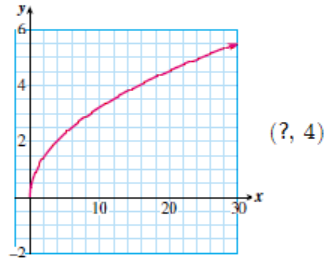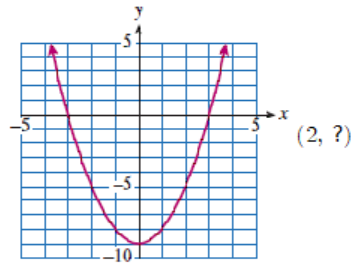Section 1.2 Graphs and Equations
Subsection 1. Verify a solution
We can always check a solution to an equation by verifying that it makes the equation true.
Subsubsection Examples
Example 1.28.
Verify that \(x=-5\) is a solution of the equation
We show that substituting \(-5\) for \(x\) makes the equation true. When we substitute a negative number for a variable, we should enclose the number in parentheses.
Because the expression does equal \(0\text{,}\) we see that \(x=-5\) is a solution.
Example 1.29.
Verify that \(x=-3\) is not a solution of the equation
We show that substituting \(-3\) for \(x\) does not make the equation true.
The left side of the equation does not equal 8 when \(x=-3\text{,}\) so \(x=-3\) is not a solution.
Subsubsection Exercises
Checkpoint 1.30.
Decide whether the given value is a solution of the equation.
Yes
Checkpoint 1.31.
Decide whether the given value is a solution of the equation.
No
Checkpoint 1.32.
Decide whether the given value is a solution of the equation.
Yes
Checkpoint 1.33.
Decide whether the given value is a solution of the equation.
No
Subsection 2. Solve linear equations and inequalities with parentheses
Strategy for solving linear equations.
- Simplify each side of the equation: apply the distributive law, combine like terms.
- Use addition and subtraction to get all the variable terms on one side of the equation, and all constsnt terms on the other side.
- Divide both sides by the coefficient of the variable.
Subsubsection Examples
Example 1.34.
Solve \(~~3(2a-4) \ge 4-(1-3a)\)
First, we remove parentheses by applying the distributive law. Then we can combine like terms on each side of the equation.
Note that the minus sign in front of the parentheses on the right side of the equation applies to both terms inside the parentheses.
Example 1.35.
Solve the inequality \(~~25-6x \gt 3x-2(4-x)\)
We begin by the same way we solve an equation. For this example, we start by removing the parentheses.
Recall that if we multiply or divide both sides of an inequality by a negative number, we must reverse the direction of the inequality symbol.
Subsubsection Exercises
Checkpoint 1.36.
Solve the inequality \(~~-4(x+2)+3(x-2) \ge -2\)
Checkpoint 1.37.
Solve the equation \(~~4(2-3w)=9-3(2w-1)\)
Checkpoint 1.38.
Solve the inequality \(~~2(3h-6) \lt 5-(h-4)\)
Checkpoint 1.39.
Solve the equation \(~~0.25(x+3)-0.45(x-3)=0.30\)
Subsection 3. Solve an equation in two variables
A solution of an equation in two variables \(x\) and \(y\) is written as an ordered pair, \((x,y)\text{.}\) For example, the solution \((-2,5)\) means that \(x=-2\) and \(y=5\text{.}\)
Subsubsection Examples
Example 1.40.
Is \((-3,2)\) a solution of the equation \(~~x^2+4y^2=25\) ?
We substitute \(x=\alert{-3}\) and \(y=\alert{2}\) into the equation.
The ordered pair \((-3,2)\) satisfies the equation, so it is a solution.
Example 1.41.
Which of the following ordered pairs are solutions of the equation whose graph is shown?
- \(\displaystyle (-3,-2)\)
- \(\displaystyle (-5,0)\)
- \(\displaystyle (1,-4)\)
- \(\displaystyle (-1,-6)\)
The graph of an equation is just a picture of its solutions, so points that lie on the graph are solutions of the equation.
The points \((-3,-2)\) and \((-1,-6)\) lie on the graph, so they represent solutions of the equation. The points \((-5,0)\) and \((1,-4)\) do not lie on the graph, so they are not solutions of the equation.
Subsubsection Exercises
Checkpoint 1.42.
Find a solution of the equation with the given coordinate.
Checkpoint 1.43.
Find a solution of the equation with the given coordinate.
Checkpoint 1.44.
Find a solution of the equation with the given coordinate.

Checkpoint 1.45.
Find a solution of the equation with the given coordinate.

